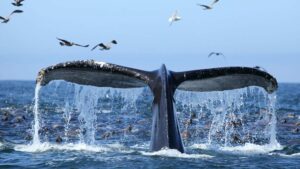Samaná could be considered to perfectly exemplify the slogan “it has it all” of the RD. In fact, it has a little more, considering that it is the only destination on this half-island that receives dozens of humpback whales for arrivals and births every year.
The RD has the Banco de la Plata and Banco de la Navidad marine mammal sanctuaries in Samaná, created in October 1986. Not only were they the first such protected areas established worldwide or the largest national marine reserve, they were also the first marine mammal sanctuary in the Atlantic Ocean.
As a result, every year between mid-December and the end of March, thousands of humpback whales arrive in the warm waters off the coast of the RD to mate and give birth. In 2021 alone, 605 humpback whales and 18 calves were recorded being born in Samaná, a figure that had increased to 48 calves a year later, when the number of marine giants had been reported at 944, the highest number in the last five years, according to data provided by the Ministry of Environment and Natural Resources (Mimarena).
Whales in the Caribbean
Biologist Nelson García Marcano explained to elDinero that between 800 and 900 whales arrive in the Caribbean annually, and at least 252 humpback whales have been identified in the bay of Samaná. The sighting of the so-called mystic cetaceans in the country was first established in 1985 and since then, the activity has contributed to the proliferation of the species.
“The number of whales that visit us every year has increased. The species was even on a list prepared by the International Union for Conservation of Nature (IUCN), where  it was classified as vulnerable or vulnerable technical species due to the high pressures that cause the population to decrease”, said García.
it was classified as vulnerable or vulnerable technical species due to the high pressures that cause the population to decrease”, said García.
Currently, whale populations are more stable. It was in 2019 when this species that mainly inhabits the South Atlantic Ocean recovered its numbers after dangerously verging on extinction because of the whaling industry, one of the most extensive and destructive forms of exploitation of natural resources worldwide.
Sanctuaries
The La Plata and Navidad Marine Mammal Sanctuary is one of the few coastal marine protected areas in the insular Caribbean where the ecological and biological processes associated with the ecosystems it shelters are maintained in perfect condition. They cover a total area of 32,913 km, which represents the largest conservation area in the RD, known as Marine Mammal Sanctuary (MMDR).
These were created by Decree No. 319 of October 14, 1986 and currently belong to Category I, Scientific Reserve in the National System of Protected Areas, which corresponds to an IUCN Strict/Wild Natural Area.
According to the United Nations Educational, Scientific and Cultural Organization (Unesco), both areas contain some of the most important and significant natural habitats for in situ conservation of the Caribbean’s biological diversity, especially humpback whales.
For this reason, the area has been proposed as a critical habitat for the survival of this species, within the framework of the Biodiversity Agreement. Thus, Samaná is emerging as a destination of utmost importance for the humpback whale species, serving as a cradle for new calves, where they feed until they reach the necessary development to migrate with their mothers.
Importance of sanctuaries
Unesco highlights the importance of the sanctuaries, first of all, because the protection of this area preserves critical habitat for the reproduction of a population of some 3,000 humpback whales in North America that migrate each year to the warm waters of the Caribbean during the winter season. In fact, they estimate that 85% of the North Atlantic humpback whale population uses the Sanctuary’s waters for vital functions, mating and reproduction.
Data from Mimarena is more specific regarding the number of calves registered locally each year, which would certify the number that can be considered Dominican. Between 2018 and 2023, some 138 “baby whales” were reported, with 2022 being when the largest number was seen, reaching 43 calves in national waters.
“An important fact is that the whales are Dominican since they are born here and go north to look for their food and return to us, an important element that we must highlight and that makes us feel proud,” García highlighted.
Source: Mitur.com
Know More: Nature

